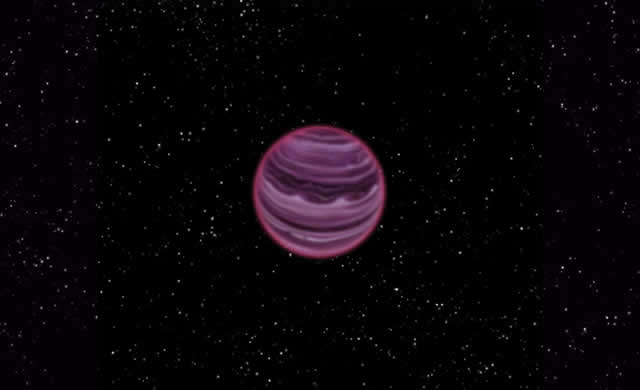
PSO J318.5-22. Credit: MPIA/V. Ch. Quetz
Un team internazionale di astronomi ha scoperto un giovane pianeta esotico che non orbita intorno ad alcuna stella. Questo pianeta libero di fluttuare nello spazio, denominato PSO J318.5-22, si trova a soli 80 anni luce di distanza dalla Terra e ha una massa solo sei volte quella di Giove. Il pianeta deve essersi formato circa 12 milioni di anni fa, praticamente da considerarsi un neonato rispetto all’età di vita dei pianeti.
E’ stato identificato grazie ad una specie di firma riconoscibile attraverso il suo calore debole ed unico, osservato con il telescopio per survey a grande campo Pan- STARRS 1 ( PS1 ) sul vulcano Haleakala a Maui, nelle Hawai’i. Osservazioni effettuate con altri telescopi delle Hawaii mostrano che il pianeta vagante ha proprietà simili a quelle dei pianeti giganti di gas scoperti in orbita attorno a stelle giovani. Eppure PSO J318.5-22 è tutto da solo, senza una stella che lo ospiti.. “Non abbiamo mai visto prima un oggetto libero di fluttuare nello spazio, simile a questo. Ha tutte le caratteristiche dei giovani pianeti trovati intorno ad altre stelle, ma questo sta andando fuori alla deriva tutto da solo”, ha spiegato il capo del team di ricercatori Dr. Michael Liu dell’ Istituto di Astronomia presso l’Università delle Hawaii a Manoa. “Mi sono chiesto spesso se esistessero tali oggetti solitari, ed ora lo sappiamo e ne abbiamo conferma. ” Negli ultimi dieci anni , i pianeti extrasolari sono stati scoperti ad un ritmo incredibile, con circa un migliaio di casi trovati con metodi indiretti come l’oscillazione o l’affievolimento della loro stella ospite, indotto dal pianeta. Tuttavia, solo una manciata di pianeti è stato ripreso direttamente e sono tutti intorno a stelle giovani (con meno di 200 milioni di anni). PSO J318.5-22 è uno degli oggetti che fluttuano liberamente con la massa più bassa mai registrata, forse la più bassa in assoluto. Ma il suo aspetto più singolare riguarda la sua massa simile al colore e alla produzione di energia per i pianeti acquisiscono direttamente. ” I pianeti trovati da osservazione diretta sono incredibilmente difficili da studiare, dal momento che sono proprio accanto alla loro molto più brillante stella. PSO J318.5-22 non orbita intorno a una stella, quindi senza il disturbo di una luce intensa nelle vicinanze, sarà molto più facile per noi studiarlo. Si sta per fornire una vista meravigliosa nel funzionamento interno del gas dei pianeti giganti come Giove poco dopo la loro nascita”, ha detto il dottor Niall Deacon del Max Planck Institute for Astronomy in Germania e un co- autore dello studio.
An international team of astronomers has discovered an exotic young planet that is not orbiting a star. This free-floating planet, dubbed PSO J318.5-22, is just 80 light-years away from Earth and has a mass only six times that of Jupiter. The planet formed a mere 12 million years ago—a newborn in planet lifetimes.
It was identified from its faint and unique heat signature by the Pan-STARRS 1 (PS1) wide-field survey telescope on Haleakala, Maui. Follow-up observations using other telescopes in Hawaii show that it has properties similar to those of gas-giant planets found orbiting around young stars. And yet PSO J318.5-22 is all by itself, without a host star. “We have never before seen an object free-floating in space that that looks like this. It has all the characteristics of young planets found around other stars, but it is drifting out there all alone,” explained team leader Dr. Michael Liu of the Institute for Astronomy at the University of Hawaii at Manoa. “I had often wondered if such solitary objects exist, and now we know they do.” During the past decade, extrasolar planets have been discovered at an incredible pace, with about a thousand found by indirect methods such as wobbling or dimming of their host stars induced by the planet. However, only a handful of planets have been directly imaged, all of which are around young stars (less than 200 million years old). PSO J318.5-22 is one of the lowest-mass free-floating objects known, perhaps the very lowest. But its most unique aspect is its similar mass, color, and energy output to directly imaged planets. “Planets found by direct imaging are incredibly hard to study, since they are right next to their much brighter host stars. PSO J318.5-22 is not orbiting a star so it will be much easier for us to study. It is going to provide a wonderful view into the inner workings of gas-giant planets like Jupiter shortly after their birth,” said Dr. Niall Deacon of the Max Planck Institute for Astronomy in Germany and a co-author of the study.
Source/Continue reading → www.ifa.hawaii.edu





















